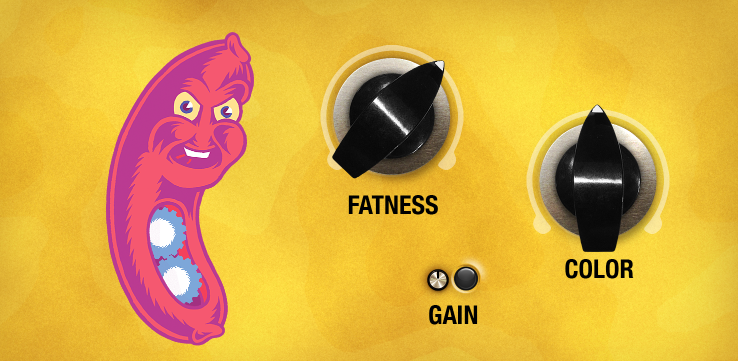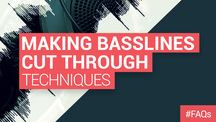So, you make electronic music such as Hip Hop, Drum & Bass, Techno, Deep House, Garage… – in fact, any type of dance music. You want your basslines to thump in the club, in the car, through the home system, and even on crappy radios, right? Do you have a problem making your basslines thump in different audio systems? Do they sound nice on one set of speakers, but weak on the next? Are you having a hard time getting the power you want from your basslines without making the mix too muddy or distorted?
Bass is almost definitely the hardest part of music production to master. It requires some knowledge of sound selection, frequencies, waveform behaviour, masking, sidchaining, distortion, dynamic range and more. And if you go too far on the low end, you can easily destroy the rest of your track in the process. Whether you're making a pounding tech house bassline or an weighty EDM sub, with these tips, though, we'll give you a helping hand with polishing and tightening up your sub frequencies, giving you the bassline production techniques to sound exactly how you want and to provide the weight and power in your track.
The Frequency Range
If you're making basslines you want to bang in a system with nice subwoofers AND in crappy home shelf systems, it is pointless to use a bass patch whose energy lies only below 40Hz, because most home systems will not play sounds that low in frequency. You need to make sure that the bass has a lot going on in the 70-90 Hz frequency range. So just how do you do this? How to make a good bassline that is both felt and heard on a number of different speaker systems?

Layering Other Waveforms
The sine and triangle wave produce that low thumping bass tone we electronic composers love (e.g. sub bass, 808 boom, DnB drone). These waveforms have few or no harmonics, so they are felt more than they are heard. If using a synth (or even a sampler), try layering these waveforms with a waveform rich in harmonics, such as a square or saw wave. After layering, use the synth’s or sampler’s low pass filter cutoff to do some bass EQ and trim away some of the higher harmonics from this new sound.

Distorting for Harmonics
Start with your favorite bass sound – one that happens to be low in harmonics (like the sub bass and synth bass discussed above), and add some distortion or overdrive. Use anything with a tube (tube preamps, tube compressors) or a dedicated distortion unit (guitar distortion pedals, plugins, etc). This will add harmonics to the bass sound so that it will be heard in a higher register for those people with less ideal speaker systems, but still felt for those of us using speakers with more bass response.

Octaves
If programming with a synth or sampler, use two oscillators (or create a multi-layered sampler patch). Set one of the oscillators or sample layers to be an octave below the other. Lower the volume on the higher octave layer so that it is just heard. This will ensure that your thumping bass patch can be heard in both the lower and mid frequency ranges.

Percussive Attack
Another approach is to layer your bass patch with a percussive sound, such as a bass drum. Lengthen the attack of the percussive sound to make it less drum like. To do this, raise the attack time on the amp envelop of your sampler or synth (this is usually the “A” of the ADSR on most synths and samplers). If you cannot do this with your sampler, use any wave editing software you may have (or your sampler’s sample editor) to slightly fade in the percussive sound, then save it as a new sound. Layer this new percussive sound with your bass patch. This will make the bass patch punchier, and thus help it to cut through the mix, even on a system with low bass response.

Real Bass
Yet another layering approach for bassline production is to layer your deep synth bass patch with a real bass. This can either be an actual recorded bass guitar, or a patch in your sample library that sounds like a real bass. Since real basses are usually higher in frequency and more punchy than synth basses, your deeper synth bass will be heard and felt more on systems with good bass response, but the real bass layered over the top will be heard more for those with less fortunate systems. When it comes to mixing bass guitar, spend plenty of time finding where the character lies in the patch with an EQ boost, and remove this frequency from competing instruments.

Enhancements
Another tip is to use a bass enhancement plugin (such as Waves MaxxBass), which essentially adds psychoacoustically calculated harmonics to the sound in order to trick the human ear into believing that the missing lower bass frequencies are actually there. This occurs because the human’s auditory system has the ability to recreate missing fundamental frequencies from remaining harmonics present in the bass tone. Bass enhancement systems will allow you to bring this out in your existing bass sound – far more sophisticated than just using a bass equalizer.
Compression is Key
Ever made a bassline that switched between lower and higher notes throughout the song? The low notes are fine in relation to the volume, but the higher notes stick out like a sore thumb? Or the higher notes are fine, but the lower notes are too low to be heard? To correct that problem, try a little compression. Do not overdo it, though, or you will kill all the dynamics and emotion in the bass part. With basses, start with a Ratio of between 3:1 to 8:1. If you're using a synth-like bass, a quick attack would be advised. If you're using a more plucked or slappy type bass, use a longer attack to allow for the initial “pluck” to pass through uncompressed, but the rest of the note to be compressed.
















